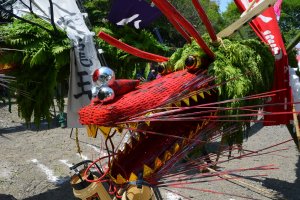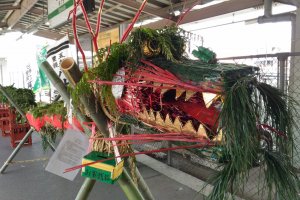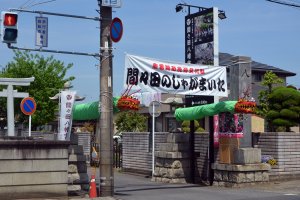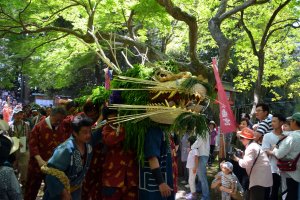For most of the year, Mamada, Tochigi Prefecture, is just your typical sleepy small town. There's an art museum and a local history museum, but otherwise not much reason to get off the train here. Unless it's the 5th of May (Kodomo-no-hi, Children's Day), when the annual Mamada no Jagamaita festival is held, one of the more unique matsuri in the Kanto area.
Origins of the Mamada no Jagamaita
The festival revolves around seven large snakes with dragon heads (but don't call them dragons though!), made by junior high school students from different neighborhoods of Mamada. The snakes are about 15 meters long and mostly made from bamboo and straw. On the day of the festival they are covered with fern leaves. I don't know the weight of the snake, but as I can tell from my own experience, even when carried around by so many people, it is still pretty darn heavy.
The festival is held as a prayer for rain and protection from plague to help ensure a good rice harvest. It is thought to date back over 400 years, though the exact origins are uncertain. In its current form it is believed to have started during the Meiji era, although it wasn't until the Showa era that the snakes that are carried around started growing to their current size.
During the festival day
In the morning, all seven snakes are carried from their neighborhoods to gather at the Mamada Hachiman Park surrounding the Hachimangu shrine. From about 10am the snakes (and a few smaller ones) are on display in the park, where there are also taiko performances and a few yatai stalls. If you want a good spot for the main event, you might want to ignore all of that, as it will get very busy and spots with a good view are rather limited.
The main event starts at noon, when the snakes are first carried to the Hachimangu shrine to receive a blessing (and some sake...) from the priest. Next is what is considered the highlight of the festival, the "Mizunomi". Even after the sake, the snake is still thirsty, and to quench that thirst it is carried into the pond to have a drink. It seems all of the groups try to outdo each other in making a spectacle out of this moment.
After the snakes have had their fill, the park activities are mostly over and the yatai dismantled. The festival itself is far from over though. Each snake returns to their own neighborhood, moving around most of the afternoon to thank the locals with a small ceremony at their homes. This lasts for a few hours, obviously involving quite a few breaks for a drink, something to eat and a moment of rest. It probably helped that I was one of the very few non-Japanese around, but these moments were a lot of fun and the group I was following insisted that I help carry the snake for a bit. One other detail I noticed was how the group had two ladies following the snake, picking up even the tiniest bit of fern that fell off. As they say, only in Japan...
Wild chase
Late in the afternoon, some of the snakes gather in front of Oyama Shiritsu Mamada Elementary School for the final and most chaotic event: "Hebi mo mi". Groups with the snakes will go circling around the school grounds a couple of times, trying to get their snake on top of the other ones. While it might start off calm, it doesn't take long before everyone is running around like crazy. The combination of heavy snakes, fatigue and quite a bit of alcohol can make this part a bit dangerous, proven by the two times an ambulance was needed during my visit....
And then, just like that, it's all over. The snakes are carried back to their home base, and they bring out a chainsaw. The head remains but the rest of the snake is quickly cut into pieces and disposed of. And again: not a single fern leaf or the tiniest bit of straw will be left on the streets...

































